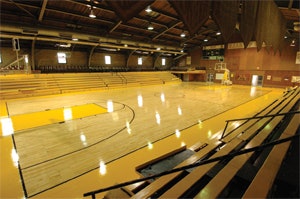Fitness, recreation and athletic facilities rebound one year after Hurricane Katrina's wrath.

Clearly, the "we will rebuild" mantra voiced by so many politicians - including recently re-elected mayor Ray Nagin - needs some tweaking.
But life goes on; it must for the many residents who have returned to New Orleans in Katrina's wake. That's why high school and college athletic directors, parks and recreation administrators, and fitness facility operators have been doing their best to restore some sense of normalcy nearly a year after Katrina wrote its own chapter in American history.
Many New Orleans health clubs reopened months ago in an effort to provide citizens and recovery crews with relief from gutting houses and navigating sticky insurance-company red tape. Membership numbers were strong, operators say, at facilities that managed to remain open or reopen to the city's drastically reduced population.
The desire to seek relief through physical activity was also apparent at New Orleans high schools. Chartered Edna Karr School was among the first to reopen, in mid-December, and despite the storm swallowing its six-year-old gymnasium roof, Karr assembled skeletal boys' and girls' basketball teams that played abbreviated away-game seasons. "The kids were thankful just to have something to do," says Roch Weilbaecher, Karr's athletic director and assistant boys' basketball coach. "They had been sitting in a house or a hotel room for so long that they were looking forward to some activity."
A total of 31 Louisiana schools lost all or portions of their fall sports season to Katrina and her Sept. 24 successor, Hurricane Rita, according to the Louisiana High School Athletic Association. Half of them may not be ready for this fall's season, either. Karr forfeited the use of city-owned Behrman Stadium when it became a staging area for rescue workers, and the school will play all of this season's football games on the road. Last year's washed-out football season and away-game-only schedules left no gate receipts, and what remained of the athletics budget was drained to cover repairs to other parts of the school. As a result, Karr (which regained the majority of its pre-Katrina 700-plus student body) suspended golf, swimming and tennis; coaches work for free; and Weilbaecher scheduled several non-conference football games based on how much money the host school offered. "You talk about a shoestring budget; this is a sandal budget," he says.
Other New Orleans high schools reportedly regained only a quarter of their student bodies and merged with other schools or completely relocated. Archbishop Hannan High School in St. Bernard Parish is rebuilding, but until the new facility is completed, three modular classrooms have been erected 54 miles away from the school's original site. Sporting events and practices will be held at venues as disparate as Southeastern Louisiana University (80 miles from Hannan High) and the youth-oriented Coquille Sports Complex in Covington, some 60 miles away.

Like Tulane, Dillard and Xavier universities, which scrapped their entire 2005-06 sports seasons, plan to field fewer sports than normal this year. Floodwaters at Xavier, which eventually regained almost 75 percent of its pre-Katrina enrollment after reopening in January, buckled the gymnasium's new wood floor and caused severe damage to locker rooms and athletic department offices. But the only sport still suspended is volleyball, the most recent addition to Xavier's program. "It was always our intention to bring back the athletics program as soon as it was feasible," university president Norman Francis says. "Classrooms and learning are not all of what we do. What goes on outside the classroom is so important to the development of individuals."
Area parks and recreation departments also have made a lot of progress, with many ballparks, swimming pools and municipal gymnasiums reopening in time for summer. Likewise, administrators report a surge in program and team registrations, which inspired staff members to rededicate themselves to the recovery efforts. Crews with the Plaquemines Parish Recreation Department, for example, camped out in trailers set up by the Federal Emergency Management Agency near the playing fields in order to massage them into shape in time for the spring baseball and softball seasons.
But even as the New Orleans Recreation Department rehired laid-off staff members to operate and maintain repaired playgrounds and pools, city officials shifted $1.1 million, primarily from recreation funds earmarked for improvements to Joe Brown Park, to help defray nearly $4 million in Katrina costs at City Hall - including new shutters and a second power generator. "I understand the short-term need for the transfer, but youth recreational opportunities should be given the highest priority," council member Arnie Fielkow told the New Orleans Times-Picayune. "There's nothing more important than the youth of our community."
Indeed, if positive aspects of the Katrina experience can be found, one of them certainly must be that it forced facility operators and program administrators to reassess the valuable roles they play in their communities and to make the best of the opportunities they've been given - and to do so today. Weilbaecher, for one, no longer takes his job for granted. "Something like this definitely changes your perspective," he says. "You think that you'll be coaching forever. But if the big one comes again this year - I hate to say it - we could be finished forever. I know people aren't coming back."




































